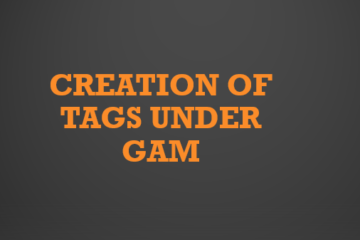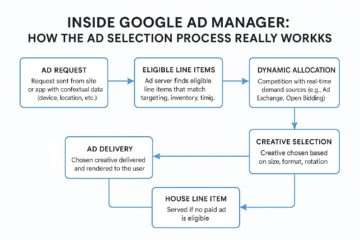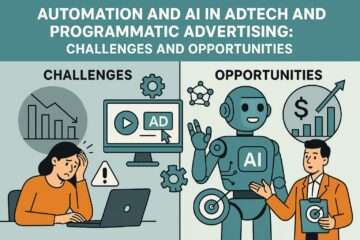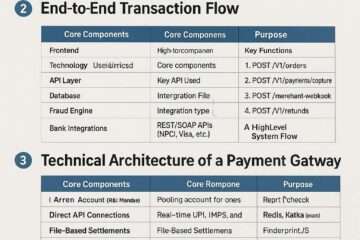

Advertising is one of the key components to showcase your products and services on multiple platform to increase the knowledge and reach of of the product concerned.
Considering the Multiplicity of Options available now a days for advertising , it becomes important to catch the nerves or trends of advertising which are important to monitor to get good Return on Investment after spending advertising budget .
We will specifically examine the influence of AI, social media, and consumer behavior on the allocation of advertising expenditures. The process of creating creatives.
1. AI takes a prominent role in advertising
Artificial intelligence and machine learning are instigating a transformation in the advertising sector.
Semrush indicated that AI technology is predominantly prioritised in marketing and sales departments relative to other organisational divisions.
The Interactive Advertising Bureau projected that 80% of digital media marketers will utilise AI in some capacity in the foreseeable future.
Artificial intelligence is significantly influencing data analysis and operational effectiveness in marketing and advertising.
One statistic indicates that marketers squander 5 hours and 36 minutes weekly attempting to enhance their data operations, ultimately without success.
Advertisers are employing AI techniques to enhance the testing and optimisation of impressions, click-through rates, bid levels, and targeting.
Automated programmatic advertising.
Instead of humans dedicating days or weeks to this task, AI systems can rapidly identify patterns in the data and forecast optimal performance within seconds.
RedBalloon allocated $45,000 monthly for PPC advertising.
Subsequently, they implemented an AI software. The apparatus was capable of evaluating 6,500 permutations of a Google text advertisement daily. The company currently achieves an average return on ad expenditure of 1,100%.
Phrasee, an artificial intelligence software that creates and enhances advertising copy, collaborated with Wowcher, a daily deals platform, on a recent Facebook advertising campaign.
Human copywriting was compared to Phrasee copywriting, resulting in a 31% reduction in cost-per-lead for the AI-generated advertisements.
Bayer Australia employed artificial intelligence for trend forecasting to enhance their advertising timing and targeting during peak flu and cold epidemics.
This finally decreased their CTR expense by 33% relative to the prior year.
Artificial intelligence can accomplish more than only optimising advertisements. It can also facilitate their creation.
Advertisers are progressively utilising generative AI platforms such as ChatGPT to produce ad campaign concepts, ad language, and even creative materials.
A recent survey revealed that advertising is presently the foremost marketing application for AI tools.
Specifically, 32% of marketers utilize AI to create, execute, manage, and optimize their advertisements. A statistic anticipated to increase in 2025.
2. Video advertisements are becoming increasingly brief.
Mobile video advertising expenditure in the United States is projected to attain $53.9 billion by 2025.
The majority of the increased advertising expenditure is anticipated to be allocated to short-form video advertisements.
Contemporary customers exhibit less tolerance for lengthy videos.
Indeed, almost 25% of adults report that they will terminate a video after merely 10 seconds.
Over fifty percent said they will terminate it after twenty seconds.
An analysis determined that Instagram videos should not exceed 30 seconds, Twitter videos should be confined to 45 seconds, and Facebook videos should be capped at 1 minute.
Anticipate an increasing number of advertising specialists adhering to these principles, even opting for even greater brevity, in the forthcoming years.
Certain corporations are increasingly favouring ultra-short yet very compelling advertisements to circumvent the undesirable “skip” button on YouTube.
A recent Wyzowl survey indicates that almost all current video marketers intend to persist with video usage until 2024.
Over 95% want to sustain or augment their video spending.
Sixty-eight percent of marketers who did not utilise video intend to commence in 2024.
3. Sound Less Ads
We have all experienced the situation.
A video advertisement, which is not visible, begins to play at maximum volume on the webpage.
Research indicates that a significant portion of the population, specifically 66%, expresses disdain for video advertisements that autoplay with sound.
Outstream video is a potential popular alternative in the forthcoming years.
These videos are incorporated into the content the viewer is engaging with.
They commence playback without sound when the user hovers over them and cease once they are no longer visible.
Statistics indicate that out-stream advertisements exhibit a superior click-through rate (CTR) and prolonged engagement duration compared to in-stream video advertising.
A survey indicated that advertisers are spending up to $45 per thousand impressions on outstream advertisements.
Advertisers are adjusting to this trend by utilising captions in social media advertisements.
According to Digiday, 85% of Facebook users view videos without sound.
A recent LinkedIn survey revealed that 79% of videos on their platform are viewed without audio.
Facebook indicates that movies incorporating captions enhance viewing duration by 12%.
Animated advertisements are a readily comprehensible option for people who choose to avoid audio.
Businesses utilise visual advertisements to enhance content comprehension and emotionally engage their target audience.
Slack, the corporate communication platform, often employs animation to create compelling advertisements.
This is merely one of the reasons they are the fastest-growing SaaS firm in history.
4. Advertisers use the popularity of mobile gaming.
Approximately 70% of gamers indicate they would forgo social media or television prior to relinquishing mobile gaming.
In the same survey, participants said they are twice as inclined to focus on in-game display advertisements compared to online advertisements.
In addition to standard banner advertisements, mobile gaming applications provide interstitial advertisements and “reward” advertisements.
Interstitial advertisements are positioned during designated pauses throughout the game to ensure they do not appear incongruous to the user.
They occupy the entirety of the users’ screen.
Reward advertisements provide consumers with game points, currency, or other gaming-related advantages for viewing the complete video advertisement.
This category of advertisement has significantly enhanced engagement rates and a $30 CPM.
Data indicates that people are indifferent to viewing these advertisements.
Over 70% of players indicated that seeing video advertisements is their favoured method of compensating for in-game content.
A marketing agency indicates that sectors like healthcare, consumer packaged goods, and automotive have executed campaigns utilising game ad formats, resulting in a 10% year-over-year increase in engagement and 90% completion rates.
Certain advertisers have overlooked mobile gaming marketing due to the belief that the predominant audience of players consists solely of male adolescents.
Data indicates that 46% are women, amounting to 1 billion people. Forty percent of gamers are aged between 25 and 44.
AdColony, a mobile advertising agency, indicates that prominent corporations are embracing this trend.
Unilever, Coca-Cola, and Ford are currently making substantial investments in in-game advertisements.
Molson Coors Beverage Company has recently intensified its emphasis on advertising within gaming applications.
The corporation observed a significant influx of individuals aged 21 to 24 engaging in mobile gaming due to the epidemic and consequently reallocated the brand’s advertising budget to attract this demographic.
5. Consumers seek authenticity in social media advertisements.
While advertisers pursue enhanced efficiency via non-human resources, customers, particularly Gen-Zers and Millennials, occupy the opposing end of the spectrum.
There is a demand for more genuine communication from brands and in their advertisements.
Research indicates that over 75% of customers express greater trust in content produced by ordinary individuals compared to those generated by brands.
Marketing and advertising professionals are utilising social media to establish a balance between conventional brand material and user-generated content that reflects the brand’s human aspect.
Influencer marketing is a method employed by the advertising business to humanise its brands.
For instance, the renowned tableware brand Lenox employed influencers as a component of their comprehensive plan to transform young consumers’ perceptions of its products.
They collaborated with 32 influencers who showcased Lenox’s cuisine in diverse, unconventional household environments.
The campaign garnered over 900 link hits and exceeded potential reach projections by nearly 400%.
Other corporations have invested in unpaid brand advocacy methods via social media.
Certain companies enlist committed staff to assume a pseudo-influencer position.
Numerous enterprises are using their current customer base.
Approximately 70% of organisations are utilising or intend to utilise staff as advocates on social media.
According to EveryoneSocial, content disseminated by employees extends its reach by 561% compared to same information published via a brand’s official social media platforms.
A research indicates that 75% of marketers believe incorporating user-generated content enhances the authenticity of a brand’s message.
REI has established a devoted consumer base eager to share their experiences on social media sites.
On Instagram, #REIchallenge has surpassed 17,000 posts, while #optoutside, another hashtag initiated by the corporation, exceeds 19 million posts.
6.Amazon predominates the ecommerce advertising sector.
eMarketer reports that advertising expenditure on ecommerce platforms has risen by roughly 40% during 2019.
Amazon is the predominant entity in this advertising sector.
Amazon constitutes almost 75% of total eCommerce advertising expenditure.
Amazon’s total advertising income surpasses $7 billion. Wal-Mart follows, generating advertising revenue over $1.5 billion.
The organisation has had approximately a fourfold growth during the past four years.
In 2024 and thereafter, the platform may place greater focus on the “sponsored products” featured in users’ search results.
These products are prominently shown as the initial search results and are also mentioned at the bottom of the page.
Placement is crucial in this context.
According to one advertising agency, 35% of Amazon consumers select the initial product displayed in the search results.
The top three products account for 64% of total clicks.
Another aspect propelling Amazon’s increase in advertising revenue is the relatively low cost for companies to initiate participation.
It can yield a superior return on investment compared to SEO or search engine advertisements for numerous ecommerce enterprises.
The mean cost-per-click is merely $0.71. The mean conversion rate is 9.55%.
The average conversion rate for ecommerce sites in the US is around 2%.
Final Assessment
This concludes the primary trends influencing the advertising industry in 2024.
Digital advertising methods are rapidly evolving as customers increasingly engage with mobile devices and social media.
Seek AI tools to assist advertisers in adapting to these changes and optimising their budgets moving forward.


























































